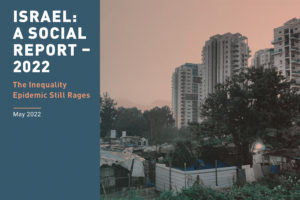The level of protection of the population is affected, among other things, by discriminatory planning policies and unequal allocation of resources. Addressing the challenge of safeguarding residential apartments in Israel requires an integrated strategy which will be devoid of profit-driven motives and based on direct state investment
A predominant concern among the majority of the country’s population is the protection of civilians in the home front. Data from the State Comptroller in 2018 paints a disconcerting picture, indicating that over two and a half million civilians, constituting 28% of the population, lack access to any standard protection measures; 38% have a shelter within their apartments (MAMAD), while the remaining 34% relay on private shelters in apartment buildings or public shelters.
Given the challenges associated with the maintenance and adequacy of numerous public and shared shelters, the primary and widely endorsed solution to ensure effective protection for the entire population is the construction of a mamad within residential units. This aligns with the directives of the Home Front Command, emphasizing that “Mamad provides the best response against the threat of rockets and missiles.”
Yet, the level of protection of the population is affected, among other things, by discriminatory planning policies and unequal allocation of resources.
In 1992, it has been mandated that every new residential construction includes a mamad. However, a considerable number of residential units constructed before 1992 lack adequate protection. Notably, there is a correlation between income levels and the presence of mamad-equipped apartments, as more affluent households, typically residing in newer developments, have a higher likelihood of having them. Consequently, there is a higher proportion of households with mamads in the higher income deciles, whereas the lower income deciles exhibit a lower percentage of households without such protection.
Presently, the primary strategy for increasing protection in existing apartments across much of the country revolves around urban renewal plans, with a particular emphasis on initiatives rooted in TMA 38 that was originally designed to strengthen buildings against earthquakes and not for protection against rocket fire. The fact that the possibility of urban renewal plans depend on economic feasibility and the potential for entrepreneurial profit left out of the plan many apartments in Israel, mainly in the periphery.
Addressing the challenge of safeguarding residential apartments in Israel comprehensively and over the long term requires an integrated strategy that includes strengthening against earthquakes and restoration of old buildings, within a broader policy of housing equality nationwide. Such a policy, which will be devoid of profit-driven motives and based on direct state investment, is the only a viable alternative to relinquishing the responsibility for protection, specifically in housing matters, to the ‘private market’.
Protection of residents of the conflict line communities in the north and south
Even the government policy of financing the construction of shelters in localities very close to the border suffers from under-budgeting and under-implementation. Apart from localities in the ‘Gaza Envelope’ within a range of up to 7 km from the Gaza border, in more distant localities, the proportion of unprotected apartments is relatively high, and the budget for construction of shelters is insufficient.
The city of Ashkelon, located beyond the 7 km range, and thus excluded from the shelters budgeting plan, has become a primary target for rocket attacks. In March 2022, the government approved a plan to protect Ashkelon from trajectory-based attacks, allocating a budget of 320 million NIS over a 5-year period. Astonishingly, a mere two weeks (!) after publishing the detailed implementation plan, on July 30, 2023, the government issued a new decision that not only froze and shelved the outlined measures but also significantly curtailed funding for loans and grants earmarked for constructing mamads in the city. In fact, the government once again shifted the primary responsibility for safeguarding the city to urban renewal programs.
The Bedouin population of the Negev is particularly under protected. The lack of shelters in the Bedouin communities results not only from the economic inability of this population to finance the construction of protected spaces, but also a result of the discrimination and neglect that characterize the government policy towards the Bedouin and Arab population in Israel.
In contrast to the communities in the Gaza Envelope, where a protection project and mamads construction were implemented in line with government decisions made in 2008 and 2012, localities along the northern border suffer from notable deficiencies in protection. According to the State Comptroller’s report, in 2018 there were 11,400 apartments lacking standard shielding in localities situated less than 4 km from the borders of Lebanon and Syria (15% of all residences in these areas). The Comptroller’s report highlighted a particularly critical situation in Arab communities in the north, that suffer from a low rate of residential protection, but also from a severe lack of public shelters.
As part of the budget proposal for the years 2023-2024 approved by the Knesset in May 2023, the budget for the “Defense of the North” program was significantly cut, and was set – under the new name “Defense of the Homeland” – to 68 million NIS in 2023 and 63 million NIS in 2024 (at 2022 prices). Although these amounts were similar to the executed amounts of the plan in previous years, they are much lower than the budget allocated for the implementation of the plan in 2022, and even lower than the original target set by the political-security cabinet, which was NIS 500 million per year.





